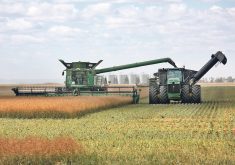Grain volume to test system | Pressure on elevators is likely to weaken basis levels, says one analyst
Western Canadian farmers are poised to harvest a monster crop, which analysts say will strain the grain handling and transportation system and pressure basis levels.
Statistics Canada forecasts 80 million tonnes of principal field crops, up from 73 million tonnes last year.
“We added everything up and it looks like a record,” said Charlie Pearson, a crops market analyst with Alberta Agriculture.
He is predicting 30.6 million tonnes of wheat and 14.7 million tonnes of canola.
The estimates are based on a survey of 15,000 farmers conducted be-tween July 24 and Aug. 5.
Read Also

Critical growing season is ahead for soybeans
What the weather turns out to be in the United States is going to have a significant impact on Canadian producers’ prices
“The widespread feeling is that the crop has only got bigger since then. Conditions have improved or stayed good,” said Jon Driedger, senior market analyst with FarmLink Marketing Solutions.
“There’s no question, no question, canola will be higher.”
Pearson said grain handlers have to prepare to move a much bigger wheat crop than the 18.7 million tonnes of wheat and durum shipped last year.
“We kind of have to be thinking about moving a 20 million-plus tonne (all wheat) crop over the coming year,” he said. “Things have to go tickety-boo and the system has to work well to move as much product through as possible.”
Exporters will be challenged to find a home for the extra wheat, canola and other crops.
“It’s a matter of establishing some new markets or else growing some existing markets,” said Pearson.
It will become a bigger challenge if the delayed crop is hit by frost and there is suddenly a glut of low quality product to move.
Pearson believes basis levels won’t be as strong as they were last year, given the size of the pending crop and the potential that elevators may become plugged if the system isn’t functioning at peak efficiency.
Driedger agreed.
“The potential for some seasonal weakness either in basis levels or in outright prices for (crops) like peas and oats is a fair concern,” he said.
“Once you get on the backside of harvest and the bins are locked, then maybe it’s a bit of a different story. At that point, (grain companies) kind of have to coax it out.”
Doug Chorney, president of Manitoba’s Keystone Agricultural Producers, said Statistics Canada’s forecast is contingent on co-operative weather. Harvest is barely underway across the Prairies, and a lot can happen between the field and the bin.
“We would be devastated by an early frost,” he said.
Chorney expects the basis to widen during harvest, but he said many growers are forward contracting grain. They have become savvy marketers of crops such as canola and wheat.
“They’re pretty cautious sellers, and they have big storage capacity on their farms,” he said.
The transportation system will be put to the test if the crop is as big as Statistics Canada is forecasting.
Chorney said the Paterson Grain terminal in Winnipeg is an example of how grain companies are approach-ing things differently this year.
“They’ve built an outdoor bunker to store winter wheat and you wouldn’t believe it unless you saw it,” he said. “I bet you could see it from space. It’s like (31,000) tonnes in a pile covered with a white tarp.”
He said the pile is the talk of coffee shop row in southern Manitoba.
“They’re obviously anticipating bottlenecks in the supply chain system in the future with all this crop coming off, so they’re trying to get ahead of it by storing this on site.”
Pearson also expects grain movement to be a little different than normal this year.
“If you look at most falls, canola gets some priority movement off the combine to China and some of those other markets,” he said. “In the new world, some companies may be putting some more priority in moving wheat off the combine.”
Pearson said there are more opportunities to move wheat under the open market and there is more wheat to move. Agriculture Canada is forecasting 4.75 million tonnes of carryout from the 2012-13 crop compared to 650,000 tonnes of canola.
“There is a fair bit of (wheat) in the system so the grain companies may actually prioritize some wheat for early movement this fall just because they have it,” he said.


















